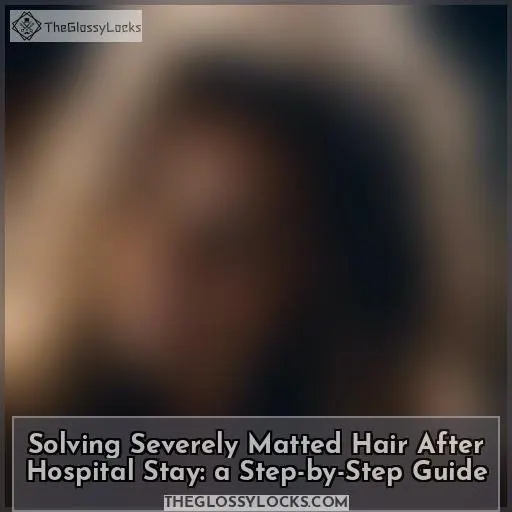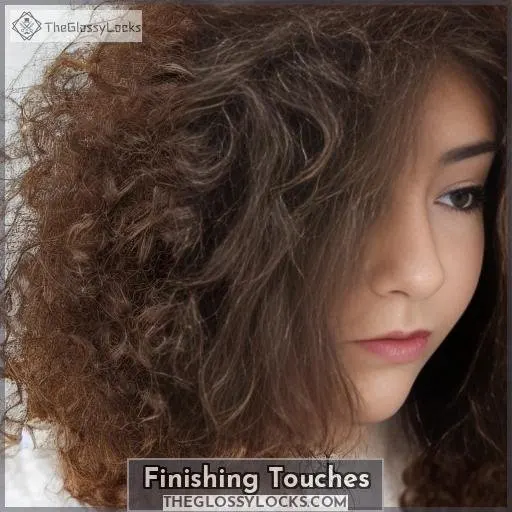This site is supported by our readers. We may earn a commission, at no cost to you, if you purchase through links.

After a hospital stay, dealing with severely matted hair can feel overwhelming, but don’t worry – there’s a solution. First, gently detangle the knots using a wide-tooth comb and conditioner. For stubborn mats, carefully thin them out with texturizing scissors.
Finish by thoroughly rinsing your hair and deep conditioning regularly to prevent future tangles. The key is taking it step-by-step with patience and care. By following these techniques, you can restore your hair’s manageability and healthy appearance.
Table Of Contents
- Key Takeaways
- Preparation
- Untangling
- Thinning Stubborn Mats
- Finishing Touches
- Prevention
- Frequently Asked Questions (FAQs)
- How can I prevent my hair from becoming matted during a hospital stay?
- What is the best way to detangle severely matted hair after a hospital stay?
- How can I protect my hair from matting while in the hospital?
- What are the best hair care products to use for detangling and preventing matting after a hospital stay?
- How can I maintain good hair hygiene during a hospital stay to prevent matting?
- Conclusion
Key Takeaways
- Gently detangle severely matted hair by starting with the easiest knots, using fingers and a wide-tooth comb, and applying conditioner or oil to stubborn areas.
- Apply hair treatments to damp hair, section by section, ensuring even distribution and adherence to product instructions for amount and duration.
- For extremely matted sections, carefully thin them out with texturizing scissors, holding the hair taut and gently tugging to remove loose strands.
- Prevent future matting by using leave-in conditioners or oils after washing and loosely braiding hair before bed to minimize tangling.
Preparation
To prepare severely matted hair after a hospital stay, start by dampening your hair with water. Then, thoroughly rub a hair treatment into each individual section of your hair, following the product’s instructions for amount and duration.
Dampen Hair With Water
Dampen your hair with water before detangling to soften it and make it easier to manage. Use a spray bottle or simply run water through your hair.
If your hair is heavily matted, you may want to use detangling spray or conditioners to help loosen the tangles.
For an extra boost, you can also mix glycerin with oil and apply it to your hair before detangling.
Rub Treatment Into Each Hair Section Separately
Applying treatment to each hair section separately is a vital step in the detangling process, especially for severely matted hair. This step guarantees that the treatment is evenly dispersed and can enter the hair strands effectively. Here’s how to do it:
- Selection of Treatment: Choose an appropriate treatment based on your hair type and condition. This could be a leave-in conditioner, olive oil, shea butter, or a combination of these.
- Portioning Hair: Divide your hair into sections, starting from the ends and working your way up to the roots. This makes it simpler to apply the treatment and detangle the hair.
- Scalp Sensitivity: If you have sensitive scalp, be gentle when applying the treatment. You may want to use your fingers instead of a comb or brush.
- Product Application: Apply the treatment to each hair section, ensuring that it’s thoroughly massaged into the hair. The amount of product needed will depend on the length and thickness of your hair.
- Detangling Duration: Allow the treatment to remain in your hair for the recommended time, usually around 30 minutes to an hour. This gives the treatment time to soften and loosen the tangles.
- Detangling: Once the treatment has been applied, use a wide-toothed comb or your fingers to gently detangle the hair. Start at the ends and work your way up to the roots. Be patient and gentle to avoid damaging your hair.
- Rinse: After detangling, rinse your hair with water to remove the treatment and any remaining tangles.
Follow Product Instructions for Amount and Duration of Treatment
To effectively resolve severely matted hair after a hospital stay, it’s imperative to adhere to the product guidelines for the quantity and duration of treatment. This will guarantee optimal outcomes for your hair type and the efficacy of the treatment. Here are some general principles to adhere to:
- Product ingredients: Select a detangling product tailored to your hair type. Consider components that provide lubrication and hydration to your hair, such as conditioners, oils, or detangling sprays.
- Treatment duration: Apply the product per the recommended duration specified on the packaging. This may vary depending on the product and the severity of your matting.
- Consistency: Maintain a consistent detangling regimen. Regularly detangle your hair to prevent future matting and tangles.
- Hair type: Customize your detangling method to your hair type. For instance, if you have curly hair, detangle while your hair is wet and utilize a wide-toothed comb.
- Product effectiveness: Assess the effectiveness of the product after using it. If you find that it’s not working effectively, consider trying a different product or adjusting your technique.
- Safety: Always follow the safety guidelines on the product label, and avoid using harsh chemicals or excessive heat that could damage your hair.
Untangling
Start by gently untangling the easiest knots with your fingers. Carefully work your way up from the ends, using a wide-toothed comb and applying extra conditioner or oil to stubborn areas as needed.
Untangle Easiest Knots With Fingers
- Start by untangling the easiest knots with your fingers.
- Finger detangling is a gentle and effective method for separating finger knots.
- Use a wide-tooth comb or rat tail comb to take out knots gently, following finger detangling.
- Coconut oil can be used to lubricate and ease the detangling process.
- Remember to be patient and gentle, as it may take time to fully detangle your hair.
Use Wide-toothed Comb to Take Out Knots Gently
After finger combing those easier knots, it’s time to bring out the big guns: your trusty wide-toothed comb. This tool is your best friend in the battle against tangled hair. Approach each section with the gentleness of a summer breeze, letting the comb glide through with ease. Remember, it’s not a race; patience is key in detangling severely matted hair.
| Tool | Use | Tip |
|---|---|---|
| Wide-toothed Comb | Gently detangle | Start at the bottom, work your way up |
| Fine-toothed Comb | Smooth out finer tangles | Use post-wide-tooth combing |
| Fingers | Loosen knots before combing | Be gentle, avoid pulling |
| Detangling Spray | Provide slip, reduce breakage | Spray liberally, let sit before combing |
| Patience | Most important tool | Take breaks, don’t rush |
Comb Ends First, Then Move Higher Up
When detangling your hair, start by combing the ends first. Use a wide-tooth comb to gently work through the knots.
If you encounter a stubborn area, try finger detangling or applying more conditioner or oil.
If the mats are too thick, consider using texturizing scissors or leave-in conditioners.
For afro-textured hair, wet hair handling can be tricky. Be patient and take your time, using the right tools and techniques for your hair type.
Apply Additional Conditioner or Oil to Stubborn Areas
When dealing with stubborn knots, it’s imperative to apply additional conditioner or oil to the affected areas. This will help soften the hair and make it easier to detangle without causing damage or discomfort. For those with sensitive scalps, it’s paramount to be gentle and avoid pulling the hair. Here are some product recommendations and techniques to help you tackle stubborn knots:
- Conditioner: Apply a generous amount of conditioner to the knotted area, focusing on the ends of the hair first. Work your way up to the roots, being careful not to tug or pull the hair. Let the conditioner sit for a few minutes to soften the knots before gently detangling with a wide-toothed comb or your fingers.
- Oil Options: You can use various oils to help detangle your hair. Some popular choices include olive oil, coconut oil, castor oil, or sweet almond oil. These oils can help reduce friction and make it easier to detangle your hair. Apply a few drops of oil to the knotted area, massage it into your scalp, and let it sit for a while before detangling.
- Deep Conditioning: If your hair is prone to tangling, consider using a deep conditioning treatment. Apply the conditioner to dry hair, cover it with a plastic bag or shower cap, and let it sit for an hour or more. This will help hydrate your hair and make it more manageable.
- Moroccan Argan Oil: This oil is known for its ability to detangle and nourish the hair. Apply a few drops to the knotted area and work it through your hair with your fingers or a wide-toothed comb.
- Easily Tangled Hair Types: If you have a hair type that tends to tangle easily, consider using a leave-in conditioner or oil after washing your hair. This will help keep your hair moisturized and prevent tangles from forming.
Remember to be patient and gentle when detangling your hair. If a knot is too severe, it may be necessary to trim it away to prevent damage. Always use a wide-toothed comb or your fingers to detangle, starting from the ends and working your way up to the roots. With the right techniques and products, you can easily manage and detangle your hair without causing damage or discomfort.
Thinning Stubborn Mats
If you have severely matted sections, you may need to carefully thin them out with scissors. Hold the hair taut and use texturizing scissors to snip through the mats, gently tugging on the hair to remove any loose strands.
Thin Stubborn Matted Sections With Scissors if Needed
When dealing with severely matted hair, thinning stubborn sections with scissors can be a necessary step. Here’s how:
- Detangling while cutting: Use a pair of safety scissors to cut through the mats, making sure to detangle as you go.
- Choose the right scissors: Keep a pair of texturizing scissors on hand for this task, as they’re designed for cutting through tangled hair.
- Store your scissors safely: Keep your scissors in a designated holder to prevent accidental cuts or damage.
- Consider hair loss: If you’re concerned about hair loss, use a sewing needle to gently loosen matted sections before cutting.
Hold Hair Taut and Use Texturizing Scissors Over Mat
Holding the hair taut is critical when using texturizing scissors to thin out stubborn mats. Gently tug at the sections while holding them taut to make sure you’re only cutting the matted portions. This process can be a bit painful, so remember to take breaks and pamper your hair.
Use a rat-tail comb to help you navigate through the mats, and consider using a texturizing spray like Pantene’s comb thru evoo scurl spray to assist with detangling.
The shingle and peel method can also be beneficial for removing stubborn mats.
Gently Tug at Hair to Remove Loose Strands
After you’ve bravely thinned out the stubborn mats with scissors, it’s time to gently tug at your hair to remove those pesky loose strands. This step is like finding the light at the end of the tunnel:
- Gently Tugging: Ease out each strand with care, like untangling the mysteries of the universe.
- Removing Loose Strands: Wave goodbye to those unwanted guests.
- Freedom: Feel the liberation as each strand comes loose, bringing you closer to tangle-free bliss.
Finishing Touches
After untangling your severely matted hair, it’s time to give it a final touch. Start by using a fine-toothed comb or brush to remove any remaining small knots.
Rinse your hair thoroughly to remove any product or treatment you applied earlier. Remember to be gentle and patient, as detangling can be a lengthy process.
Once your hair is clean and free of tangles, you can style it as desired. Don’t forget to deep condition regularly to keep your hair moisturized and prevent future tangles.
Prevention
After detangling your severely matted hair, using leave-in conditioners or oils after washing can help keep it moisturized and prevent future tangles. Loosely braiding your hair before bed is also an effective way to minimize tangling while you sleep.
Use Leave-in Conditioners or Oils After Washing Hair
After washing your hair, use leave-in conditioners or oils to hydrate and prevent tangles. This step is vital for maintaining hair health, especially for those with dry, damaged, or curly hair. Here are three ways to incorporate leave-in conditioners or oils into your hair care routine:
- Moisturize and Detangle: Apply a leave-in conditioner to towel-dried hair and comb through to distribute the product evenly. This will make your hair more manageable and easier to detangle, reducing the risk of breakage.
- Add Shine and Tame Frizz: If you have thin hair, avoid using leave-in conditioners that contain heavy oils or silicones, as they can weigh down your hair. Instead, opt for lightweight conditioners that add shine and help control frizz.
- Restore Damaged Hair: For those with damaged hair, use a leave-in conditioner to provide a protective coating against UV rays, pollution, and other external factors. This will help restore the health of your hair and prevent further damage.
Loosely Braid Hair Before Sleep to Minimize Tangling
To prevent tangles while you sleep, loosely braid your hair before bed. This simple step can protect your hair from knots and tangles, ensuring a smoother morning routine.
By sectioning your hair and securing it with a loose braid, you’ll minimize the risk of matting and breakage. Incorporate this into your nighttime routine for an easy way to maintain healthy, tangle-free hair.
Frequently Asked Questions (FAQs)
How can I prevent my hair from becoming matted during a hospital stay?
Well, isn’t that a pickle you’ve found yourself in! But fear not, my friend – with a little know-how, you can keep your locks luscious, even in the hospital. Wrap your hair in a silk scarf, and say bye-bye to tangles** for good.
What is the best way to detangle severely matted hair after a hospital stay?
Don’t worry, detangling that mess will be a breeze! Soak your hair in a deep conditioning treatment, then gently work through the knots with your fingers and a wide-tooth comb. Take your time – patience is key. You’ve got this!
How can I protect my hair from matting while in the hospital?
Weave a web of protection, dear friend. Wrap your tresses in a silky cocoon, shielding them from the hospital’s tangled web. Untangled locks await your return – a butterfly emerging, radiant and free.
What are the best hair care products to use for detangling and preventing matting after a hospital stay?
Try a detangling spray with glycerin and lightweight oils to minimize matting and smoothen strands post-hospital. Gently comb from ends to roots, and deep condition weekly to keep your hair nourished and tangle-free.
How can I maintain good hair hygiene during a hospital stay to prevent matting?
When you’re stuck in the hospital, your hair doesn’t have to be! Keep it tangle-free with a wide-tooth comb, leave-in conditioner, and gentle braiding. You’ve got this – don’t let those knots get you down!
Conclusion
Picture yourself running your fingers through your hair, feeling the soft, manageable strands once again.
By following this step-by-step guide, you can overcome the challenge of severely matted hair after a hospital stay.
With the right techniques, you’ll restore your hair’s health and appearance.
Don’t let tangled locks hold you back – take control and revive your lustrous, tangle-free hair.








